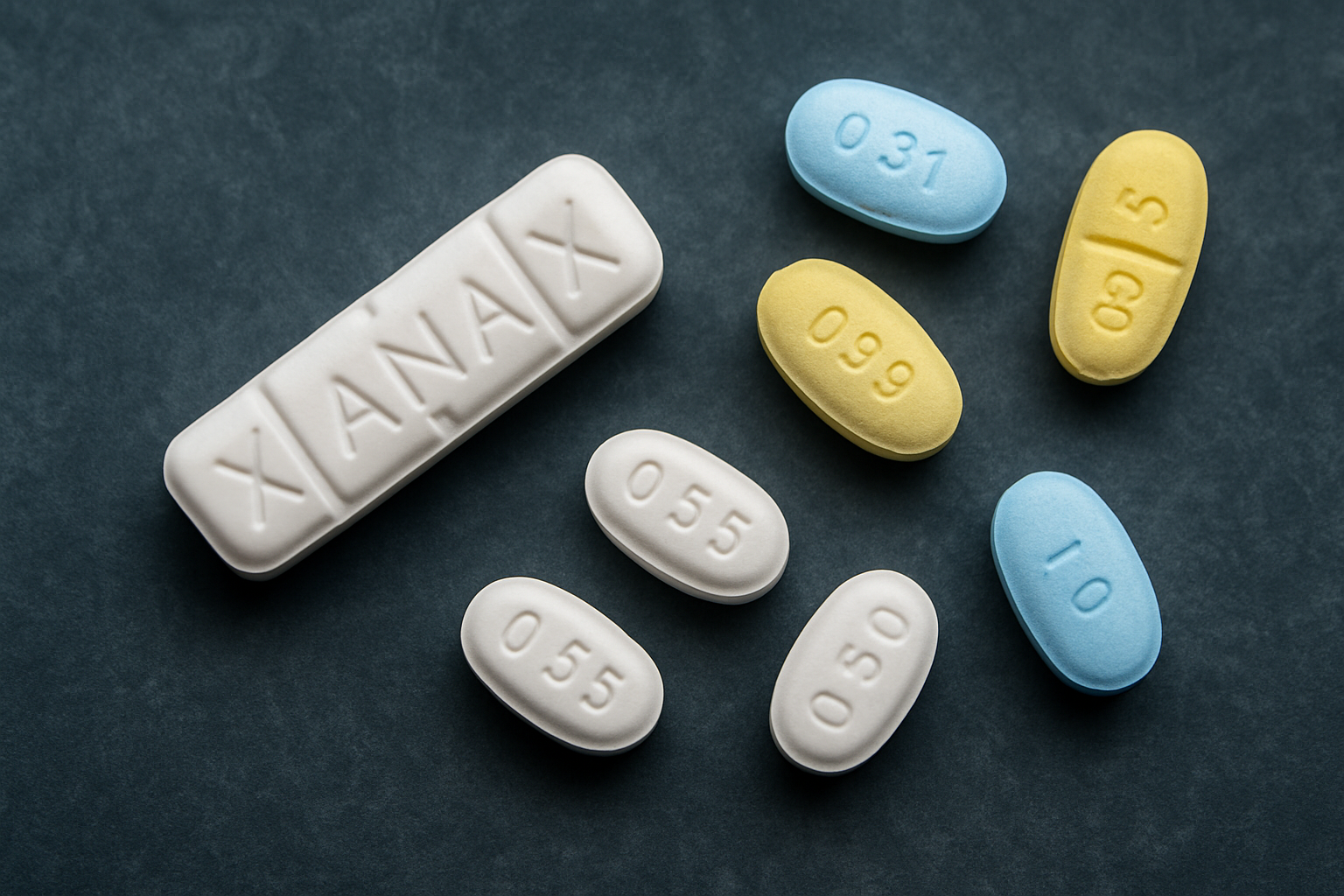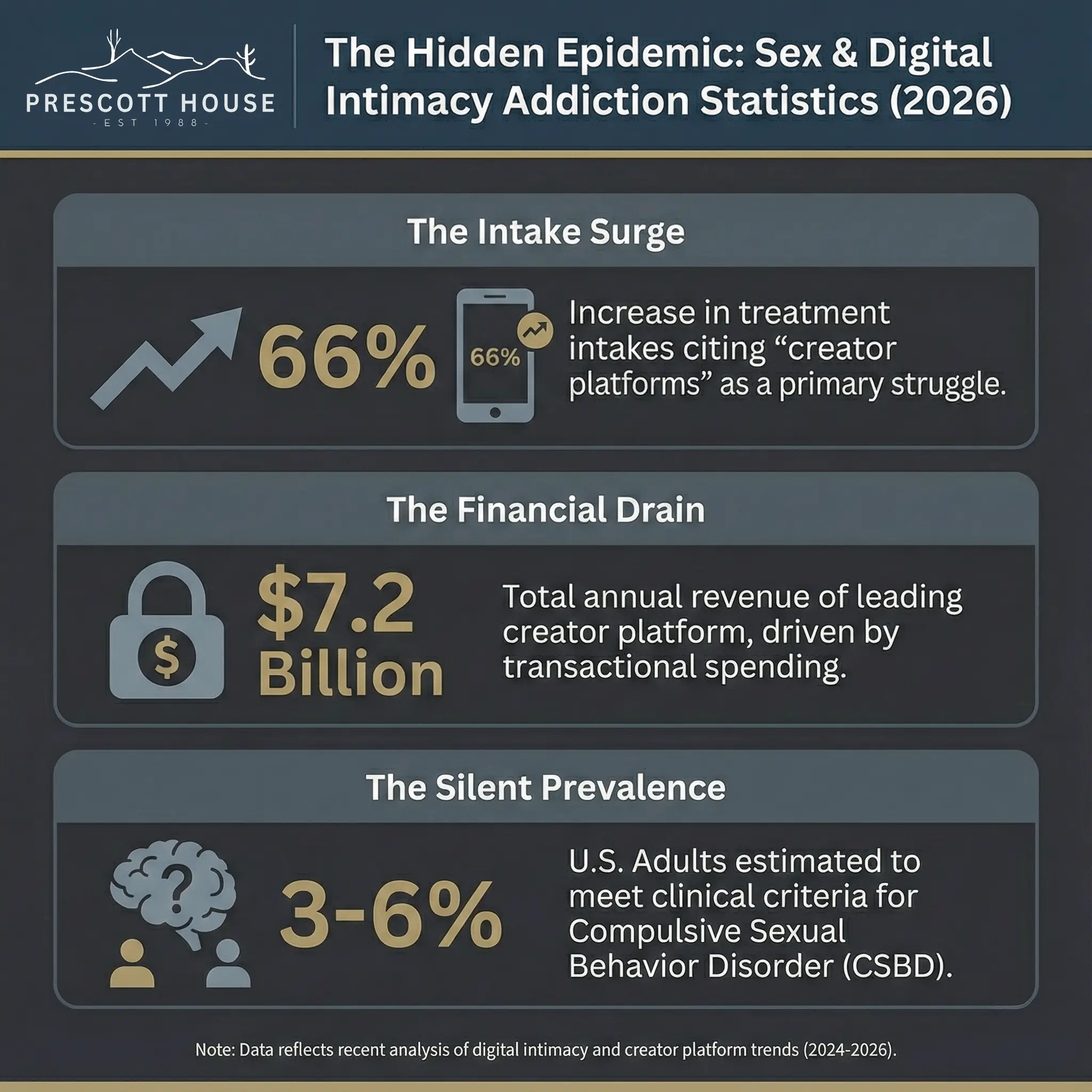Xanax, known clinically as alprazolam, ranks among the most frequently prescribed psychiatric medications in the United States. This powerful benzodiazepine effectively treats anxiety disorders, panic attacks, and various stress-related conditions. However, its calming effects have led to widespread misuse and an underground market where Xanax goes by numerous street names.
Understanding these street names isn't just street-smart trivia—it's essential knowledge for parents, educators, healthcare professionals, and anyone concerned about substance abuse. This comprehensive guide explores the world of Xanax street terminology, the dangers of misuse, and the resources available for those struggling with addiction.
What is Xanax (Alprazolam)?
Xanax belongs to the benzodiazepine class of medications that act on the central nervous system. It works by enhancing the effects of gamma-aminobutyric acid (GABA), a natural neurotransmitter that inhibits brain activity. By increasing GABA's influence, Xanax effectively reduces abnormal excitement in the brain, producing a calming effect.
When prescribed legitimately, Xanax treats several conditions:
- Generalized anxiety disorder (GAD)
- Panic disorder with or without agoraphobia
- Social anxiety disorder
- Insomnia (short-term relief)
Medical professionals typically prescribe Xanax for short-term use due to its potential for dependency. Patients usually take it in pill form, with dosages ranging from 0.25mg to 2mg, depending on their condition and individual needs.
The medication comes in different shapes, sizes, and colors—a detail that has influenced many of its street names. Standard Xanax pills include white rectangular bars (2mg), oval blue pills (1mg), orange oval pills (0.5mg), and white round pills (0.25mg).
Common Xanax Street Names
On the street, Xanax rarely goes by its clinical name. Instead, users, dealers, and even some patients adopt slang terms to discuss the drug. These code words serve multiple purposes: they conceal illegal activity, establish in-group identity among users, and sometimes describe the drug's appearance or effects.
Shape and Color-Based Names
Many Xanax street names derive from the physical characteristics of the pills:
- Bars or Xanax Bars - Referring to the bar-shaped 2mg tablets
- Footballs or Blue Footballs - Named for the oval shape and blue color of 1mg tablets
- School Buses or Yellow Buses - Describing the yellow rectangular 2mg tablets
- White Ladders or Ladders - Referencing the scoring lines on white rectangular tablets that resemble a ladder
- French Fries - Another reference to the long, rectangular shape of the bars
At Prescott House, we've heard residents refer to these pills in ways we couldn't have imagined. One gentleman always called them "bleachers" because the scored lines reminded him of stadium seating. The creativity of addiction can sometimes be darkly amusing, even as we recognize the serious nature of the problem.
Shortened or Modified Names
Many street names simply abbreviate or modify "Xanax":
- Xannies or Zannies
- Xans
- Z-Bars
- Zanbars
- X's

Effect-Based Names
Some street names describe the drug's effects:
- Downers - Referring to the sedative effects
- Chill Pills - Describing the calming sensation
- Tranks - Short for tranquilizers
- Nerve Pills - Referencing its use for anxiety
Regional Variations
Street names can vary significantly by region. For example, in some areas of the Southwest, we've encountered clients who referred to Xanax as "handlebars" or "bicycle parts," while on the East Coast, terms like "planks" or "bricks" are more common.
Understanding these regional variations can help healthcare providers better communicate with patients about their substance use history. At Prescott House, we make it a point to stay current with evolving terminology to ensure we're speaking the same language as those seeking help.
The Dangers of Xanax Misuse and Abuse
The line between therapeutic use and problematic use of Xanax can blur quickly. Medical professionals distinguish between misuse and abuse:
Misuse involves taking Xanax:
- Without a prescription
- In ways other than prescribed (higher doses, more frequent use)
- For purposes other than medical (to get high or enhance other drugs)
Abuse refers to a pattern of problematic use leading to significant impairment or distress, characterized by continued use despite negative consequences.
Physical Effects of Xanax Misuse
Short-term physical
Physical Effects of Xanax Misuse
Short-term physical effects of Xanax misuse include:
- Drowsiness and excessive sleepiness
- Impaired coordination and balance
- Slurred speech
- Slowed breathing
- Reduced blood pressure
- Nausea and vomiting
Long-term physical effects become more concerning:
- Physical dependence and severe withdrawal symptoms
- Respiratory issues
- Cognitive impairment
- Increased risk of falls and accidents
- Potential for seizures during withdrawal
One former resident at Prescott House shared that after months of heavy Xanax use, he couldn't remember entire weeks of his life. "It was like someone had taken scissors to the film reel of my memories," he said. This cognitive impact is something we see repeatedly among those who've misused benzodiazepines.
Psychological Effects
Xanax's impact on mental health can be profound and paradoxical. While prescribed to treat anxiety, misuse often worsens psychological symptoms:
- Memory problems and confusion
- Emotional blunting
- Depression and suicidal thoughts
- Irritability and mood swings
- Paranoia or delusional thinking
- Rebound anxiety (anxiety that returns worse than before)
The Overdose Risk
Xanax overdose becomes particularly dangerous when combined with other central nervous system depressants. According to recent data, benzodiazepines were involved in about 16% of opioid overdose deaths—a statistic that highlights the deadly potential of this combination.
Signs of Xanax overdose include:
- Extreme drowsiness or inability to wake up
- Confusion or disorientation
- Severely impaired coordination
- Slowed or difficult breathing
- Bluish lips or fingernails (cyanosis)
- Coma
The overdose risk increases dramatically when Xanax is taken with:
- Alcohol
- Opioids (prescription or illicit)
- Other benzodiazepines
- Sleep medications
Social and Legal Consequences
Beyond the physical and psychological impacts, Xanax misuse often leads to devastating social consequences:
- Strained or broken relationships
- Poor performance at work or school
- Financial difficulties from purchasing illicit drugs
- Legal issues (possession charges, driving under the influence)
- Loss of housing or employment
We've worked with numerous professionals at Prescott House who lost promising careers due to Xanax misuse. One attorney described how his dependency led to missing critical filing deadlines and eventually surrendering his law license. The ripple effects of addiction extend far beyond the individual user.
Signs and Symptoms of Xanax Addiction
Recognizing Xanax addiction early can make a significant difference in recovery outcomes. Key indicators include:
Tolerance
A person develops tolerance when their body adapts to the presence of Xanax, requiring increasingly higher doses to achieve the same effect. Someone who started with 0.5mg might find themselves taking 2mg or more to feel the same relief or high.
Withdrawal Symptoms
Xanax withdrawal can be not only uncomfortable but dangerous. Symptoms typically begin within 24 hours of the last dose and may include:
- Increased anxiety and panic attacks
- Insomnia and sleep disturbances
- Tremors and muscle pain
- Sweating and heart palpitations
- Nausea and vomiting
- Sensory hypersensitivity
- Seizures (in severe cases)
Unlike some substances, benzodiazepine withdrawal can be life-threatening if not properly managed. This makes medical supervision essential during detoxification.
Behavioral Changes
Addiction often manifests through behavioral changes:
- "Doctor shopping" (seeking prescriptions from multiple providers)
- Buying Xanax illegally or stealing it from others
- Lying about or hiding drug use
- Neglecting responsibilities at home, work, or school
- Continuing use despite negative consequences
- Loss of interest in previously enjoyed activities
- Social isolation or changes in friend groups
One pattern we frequently observe at Prescott House is what we call the "Xanax personality shift." Families often report that their loved ones became unrecognizable—emotionally flat, unreliable, secretive, and sometimes hostile. This transformation can be one of the most painful aspects for families to witness.
Getting Help for Xanax Addiction
Recovery from Xanax addiction is absolutely possible with the right support and treatment approach. However, the journey typically requires professional help due to
Recovery from Xanax addiction is absolutely possible with the right support and treatment approach. However, the journey typically requires professional help due to the potential dangers of withdrawal and the complex nature of benzodiazepine dependency.
Medical Detoxification
The first step in Xanax addiction treatment is usually a medically supervised detoxification. Abruptly stopping Xanax can trigger severe withdrawal symptoms, including potentially life-threatening seizures. Medical professionals typically implement a gradual tapering schedule, sometimes substituting longer-acting benzodiazepines to ease the process.
Detox facilities provide:
- 24/7 medical monitoring
- Medication to manage withdrawal symptoms
- Emergency intervention if complications arise
- Initial psychological support
At Prescott House, we work closely with medical detox partners to ensure our residents have safely completed this critical first phase before beginning our residential program. We've found that a smooth transition between detox and ongoing treatment significantly improves long-term outcomes.
Inpatient Rehabilitation
For many individuals with Xanax addiction, particularly those with severe dependency or co-occurring disorders, inpatient rehabilitation provides the structured environment needed for early recovery. These programs typically offer:
- Removal from environments where drug use occurs
- Individual therapy to address underlying issues
- Group therapy for peer support and shared learning
- Education about addiction and recovery
- Complementary approaches like mindfulness, art therapy, or exercise
Long-term residential treatment, which can last several months, provides extended support during the vulnerable early recovery period. This approach allows individuals to develop and practice new coping skills in a safe community before returning to independent living.
Outpatient Programs
Outpatient programs offer flexible treatment options for those with less severe addiction or those transitioning from inpatient care:
- Intensive Outpatient Programs (IOPs): Several hours of treatment multiple days per week
- Partial Hospitalization Programs (PHPs): Daily treatment that allows clients to return home in the evenings
- Standard Outpatient Therapy: Regular but less frequent therapy sessions
Support Groups
Community-based support plays a crucial role in long-term recovery. Options include:
- Narcotics Anonymous (NA): A 12-step fellowship for people recovering from substance addiction
- SMART Recovery: A science-based program offering self-empowerment tools
- Medication-specific support groups: Groups focused on benzodiazepine recovery
- Family support groups: Organizations like Al-Anon or Nar-Anon for loved ones affected by addiction
We've found that the camaraderie formed in these groups can be transformative. As one Prescott House alumnus put it, "In the rooms, I found people who understood my struggles without judgment. Their experience gave me hope when I had none left."
Dual Diagnosis Treatment
Many individuals who develop Xanax addiction have underlying mental health conditions that require simultaneous treatment. Effective dual diagnosis programs address both substance use disorders and mental health conditions like anxiety, depression, PTSD, or bipolar disorder.
This integrated approach might include:
- Psychiatric evaluation and medication management
- Trauma-informed therapy
- Cognitive-behavioral therapy (CBT)
- Dialectical behavior therapy (DBT)
- Holistic anxiety management techniques
At Prescott House, we've observed that untreated anxiety often drives Xanax misuse. Learning healthy anxiety management skills becomes essential for sustainable recovery. Our clinical team emphasizes developing personalized anxiety management toolkits that don't rely on substances.
The Importance of Responsible Xanax Use
For individuals with legitimate prescriptions, responsible Xanax use involves several key principles:
Follow Prescription Guidelines
Always take Xanax exactly as prescribed by your healthcare provider. This means:
- Taking the correct dose
- Following the prescribed schedule
- Never increasing dosage without medical approval
- Using the medication only for its intended purpose
Maintain Open Communication with Healthcare Providers
Honest dialogue with prescribing physicians is crucial:
- Report all side effects, even minor ones
- Discuss any concerns about dependency
- Inform your doctor about all other medications or substances you use
- Be forthcoming about any history of substance abuse
Never Share Medications
Prescription medications should never be shared, even with family members experiencing similar symptoms. What works safely for one person may be dangerous for another due to:
- Different medical conditions
- Potential drug interactions
- Varying tolerance levels
- Undiagnosed contraindications
Secure Storage
Store Xanax securely, especially in households with children, teens, or individuals with a history of substance abuse. Prescription drug misuse often begins with medications found in home medicine cabinets.
Plan for
Conclusion
Understanding Xanax street names is more than an academic exercise—it's a crucial tool for recognizing potential substance abuse and getting help when needed. The path from legitimate prescription to dependency can be deceptively short, but with awareness, education, and proper support, recovery is always possible. At Prescott House, we've witnessed countless men reclaim their lives from Xanax addiction through our comprehensive treatment approach, supportive therapeutic community, and commitment to addressing the underlying causes of substance use disorders.
If you or someone you love is struggling with Xanax misuse, remember that help is available. Our team at Prescott House is dedicated to providing the structured environment, clinical expertise, and compassionate care needed for lasting recovery from benzodiazepine addiction. We believe that with the right support, every person has the capacity to heal and build a fulfilling life beyond addiction—one day at a time.
References
- Drug Street Names: The Ultimate List - Addiction Center
- Xanax Facts, History and Statistics | Dangers and Legality
- BENZODIAZEPINES (Street Names: Benzos, Downers, Nerve Pills) - DEA
Related Xanax & Benzodiazepine Articles
- How Much Xanax Is Too Much? A Guide to Safe Use and Overdose Prevention — Learn dosage risks and how overdose can occur.
- Xanax Street Names: What You Need to Know About Alprazolam — Helps readers identify slang terms and hidden use.
- Dangerous Xanax Withdrawal Symptoms — Covers withdrawal signs, severity, and safety tips.
- How to Ease Xanax Withdrawal — Practical guidance on tapering and managing symptoms.
- Can You Detox from Benzos at Home? — Pros/cons of home detox vs supervised tapering.
- Benzodiazepines: Uses, Side Effects and Risks — Broad overview of benzos, their benefits, and dangers.
- Substance Abuse Treatment - If you or someone close to you is struggling with addiction to Xanax or any benzodiazepines we are here to help.













